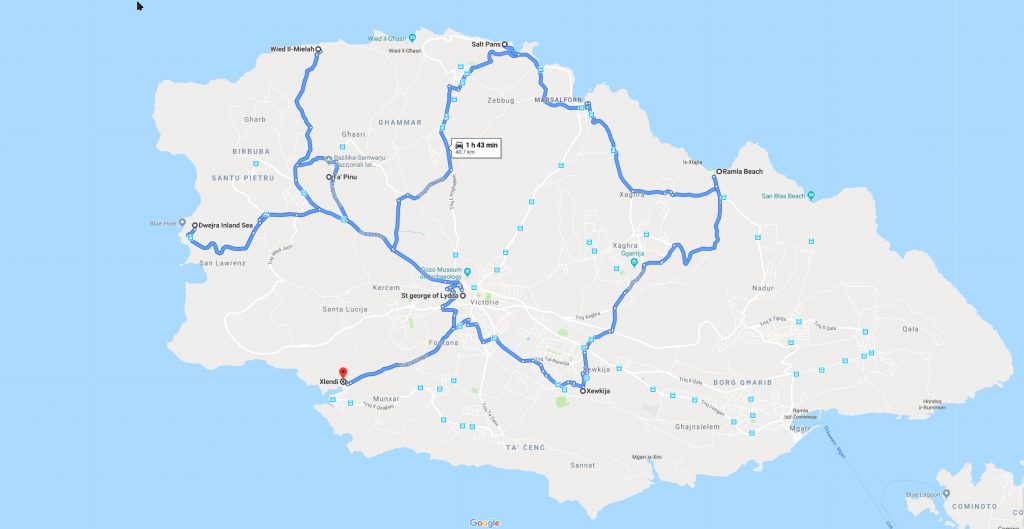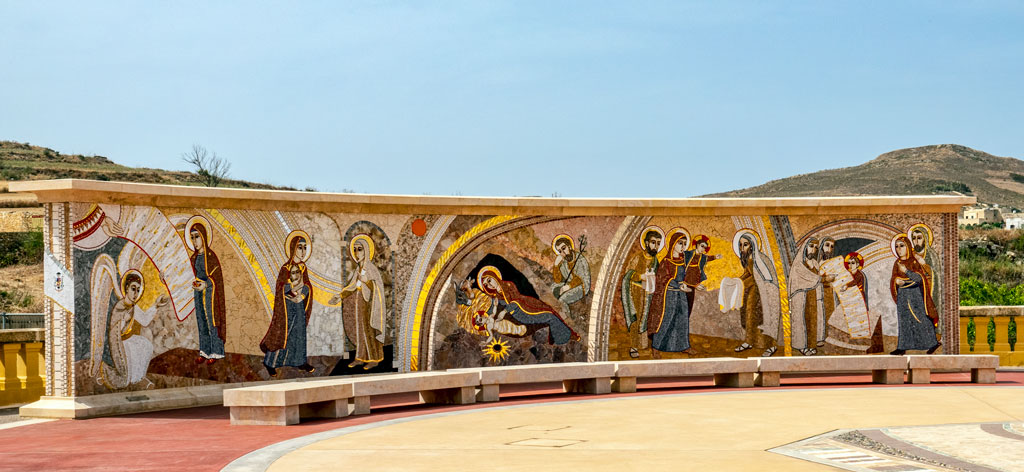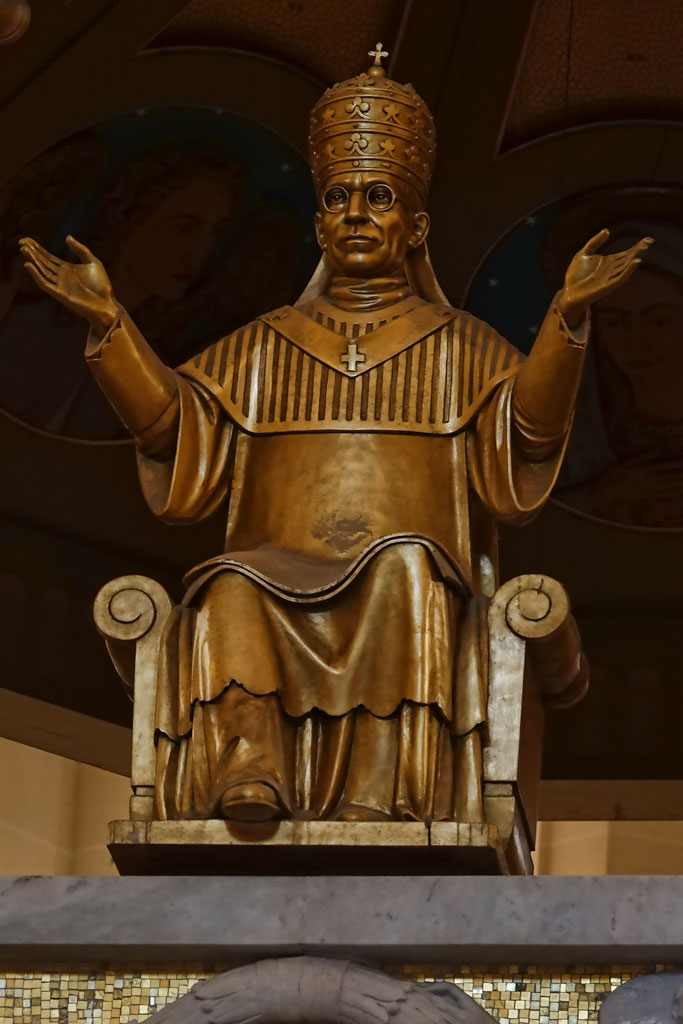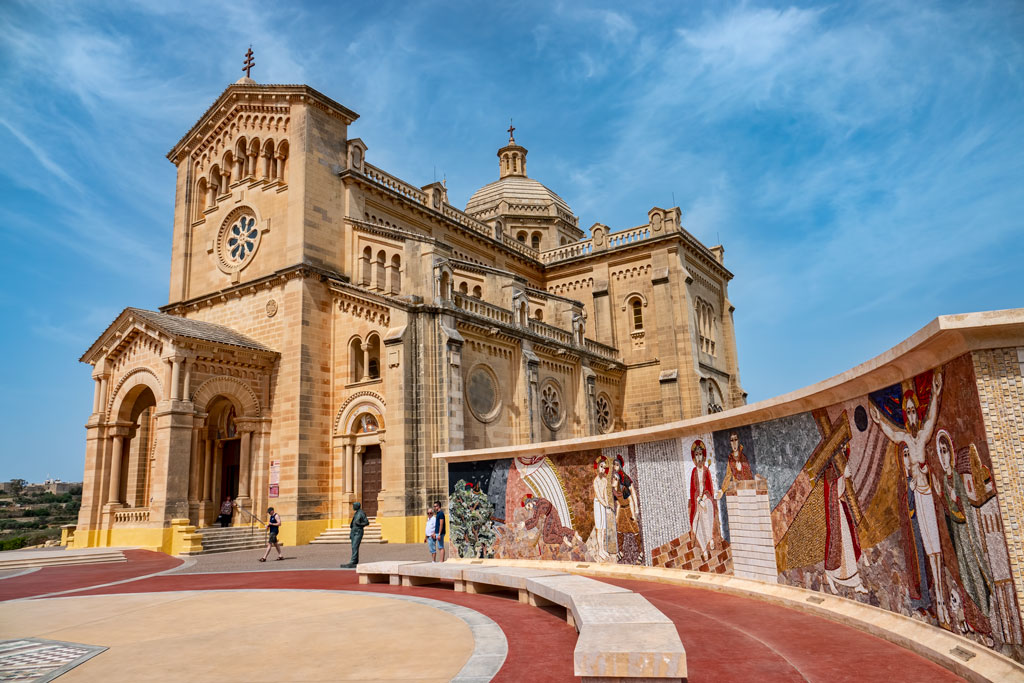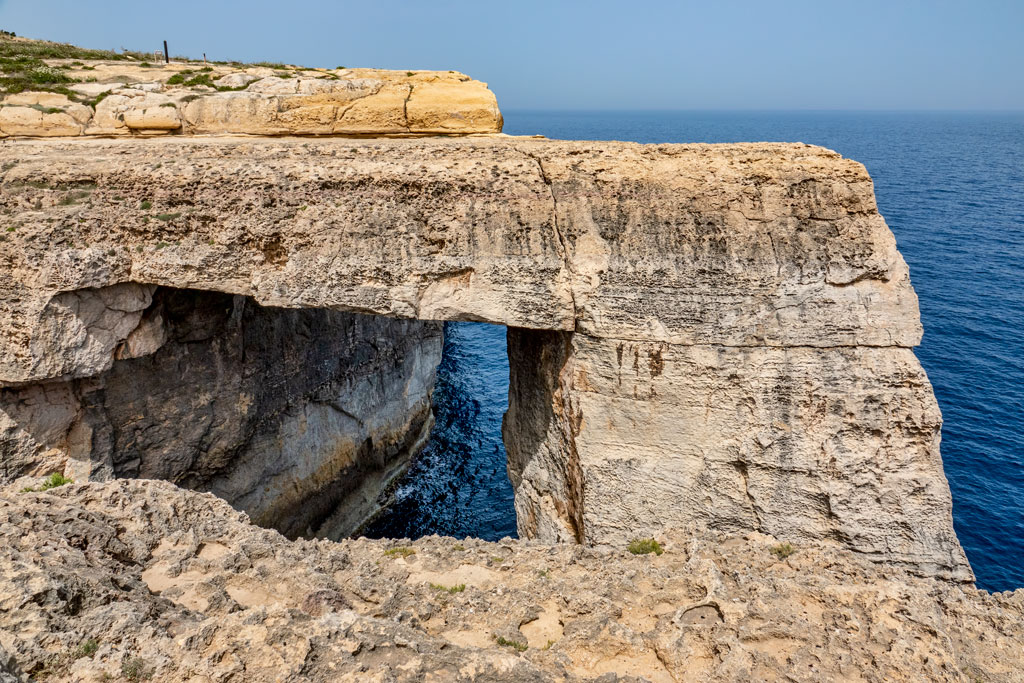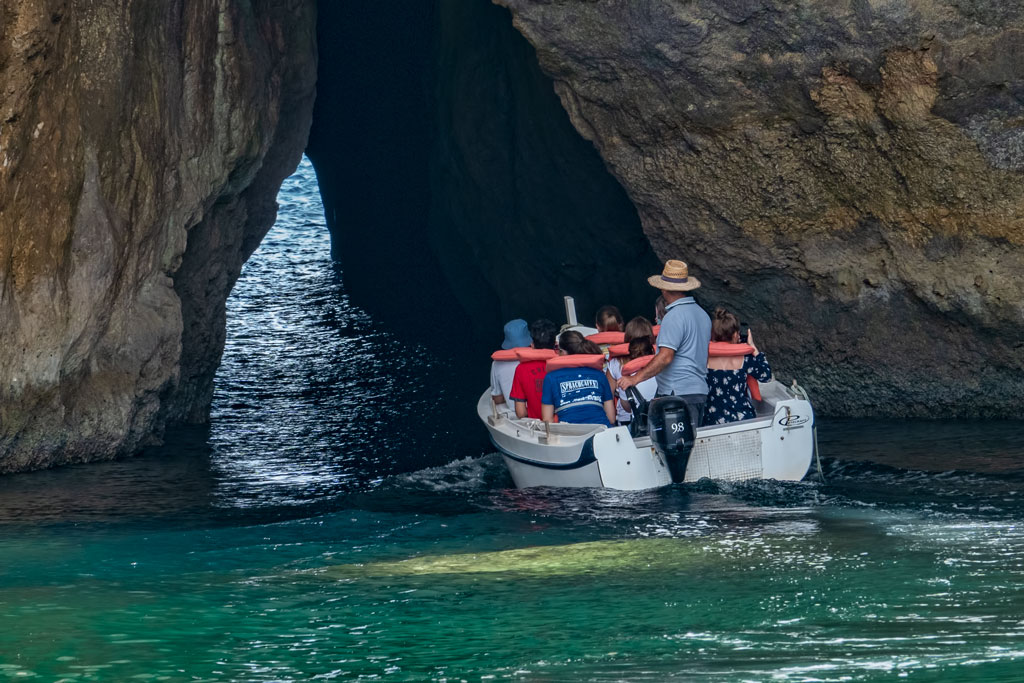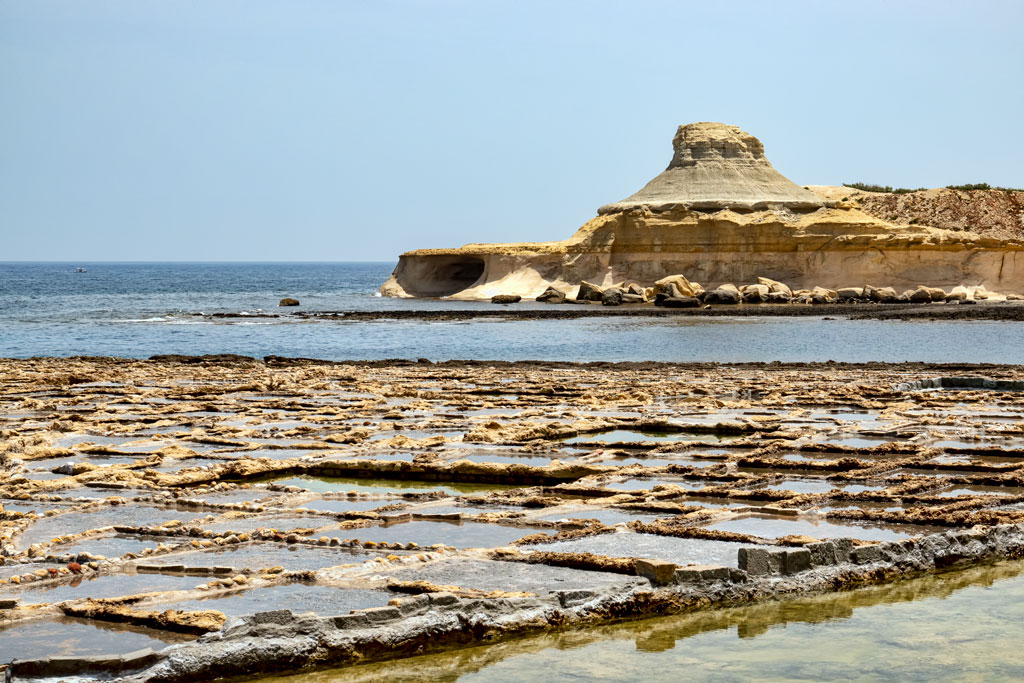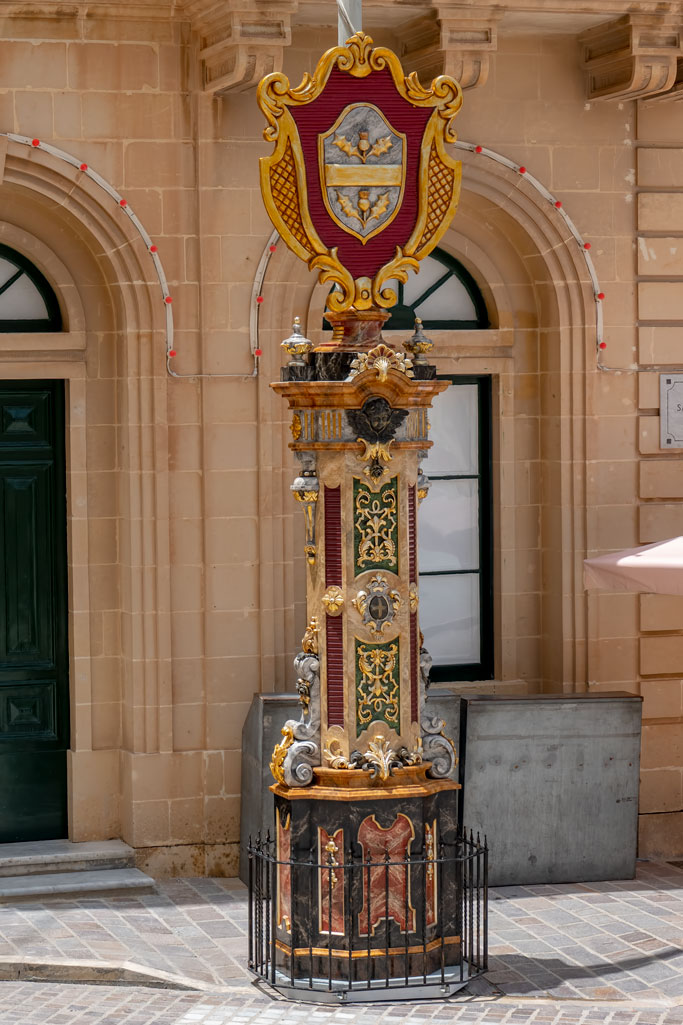TODAY’S TOURING
We hired a car & driver (M-cab) today for a 4-hour private tour of Gozo because:
- Closed arterial roads – Where we stayed was at the end of the road. The town next to where we stayed, Fontana, was closed due to a religious festival for the entire weekend (Friday through Sunday PM). The road is closed because fireworks are an important part of the festivities. The fireworks start in the morning, about 7 AM, and occur many times through out the day (e.g. 10 AM, Noon, 4 PM, 7 PM, 10 PM). The goal is the loudest firecracker to win.
- Limited open roads – Because the island is so small, there are few lengths of roads without housing located on both sides of the narrow roads. This also means pedestrians in the roadway.
- Limited parking – With the density of the population in the tourist spots, there is limited parking. A hired car knows where to park.
- No road signs – I only saw a couple of signs with almost no direction information (e.g. “Xlenda ->” sign on one street corner with no follow-up signs). Even the GPS had trouble identifying the turns quick enough to not miss the turns.
Below was the tour order:
- St. George’s Basilica (Victoria) – Historic Baroque church situated in the middle of Victoria.
- Breakfast – For breakfast we purchased fresh pastries from a Pasticceria near the church.
- Blessed Virgin of Ta’ Pinu Church – Roman Catholic basilica & national shrine with Neo-Romantic architecture & sea views.
- Wied il Mielah Sea Arch – This seaside rock formation resembling a window.
- Dwejra Bay (Qawra -Inland Sea) – A Gozo Wonder was was the Azure Window which was accessed via the Inland Sea. The Azure Window was the
backdrop for the Dothraki wedding in the Game of Thrones first season. Although it was destroyed in 2017, tourist flyers and tour advertisements still show it intact. Azure Window being destroyed - Xwejni Salt Pans – The northern coast of Gozo is characterized by a chequerboard of rock-cut saltpans, named the Xwejni Salt Pans, protruding out into the sea.
- Marsalforn – The town lies between the hill-top towns of Xagħra and Żebbuġ. Associated with this town there is also the bay of Qbajjar.
- Ramla Bay – This is Gozo’s, and arguably Malta’s, best beach. We viewed the beach from the Calypso Cave.
- Church of Saint John the Baptist (Xewkija) – This is the biggest church in Gozo and boasts the third largest unsupported dome in the world.
After the tour, we returned to the condo to rest. It was a long morning, constantly moving and seeing many things. From the condo, we saw a wild fire on the hill cross the bay. It burned for a long time, but finally ended. I don’t know if it just burned itself out or if firefighters were there. We had dinner at Ta’ Karolina with a beautiful view on Xlendi and its bay at sunset. We didn’t make it to Fontana for the evening festival because the road was closed and we would have had to walk several miles each way in the dark. We did hear the festival final evening fireworks at 11:00 PM.
REFERENCES
Basilica of St George (Victoria, Gozo) (Lonely Planet)
The well-attended original parish church of Rabat dates from 1678, and the lavish interior contains a fine altarpiece of St George and the Dragon by Mattia Preti.
Basilica of St George (Victoria, Gozo) (Lonely Planet)
The well-attended original parish church of Rabat dates from 1678, and the lavish interior contains a fine altarpiece of St George and the Dragon by Mattia Preti.
Basilica of Ta’Pinu (Gozo) (Lonely Planet)
The Basilica of Ta’Pinu, accessible via a short, scenic walk from Għarb, is an extraordinary sight – a huge, lone church on a Gozitan hillock, towering over the countryside. Malta’s national shrine to the Virgin Mary is an important centre of pilgrimage. It was built in the 1920s on the site of a chapel where a local woman, Carmela Grima, claimed to have heard the Virgin speak to her in 1883. Thereafter, numerous miracles were attributed to the intercession of Our Lady of
Pinu, and it was decided to replace the old church with a grand new one.
Built in a Romanesque style, with an Italianate campanile, it has a tranquil interior of pale golden stone. Part of the original chapel, with Carmela Grima’s tomb, is incorporated behind the altar. The rooms to either side of the altar are filled with votive offerings, including children’s clothes, hoists and plaster casts. The basilica’s name comes from Filippino Gauci, who used to tend the old church – Pinu is the Malti diminutive for Filippino.
Dwejra Point & Inland Sea (G0z0) (Lonely Planet)
The Inland Sea is a cliff-bound lagoon connected to the open sea by a tunnel that runs for 100m through the headland of Dwejra Point. The tunnel is big enough for small boats to sail through in calm weather, and the Inland Sea has been used as a fishermen’s haven for centuries. Today, fishermen supplement their income by taking tourists on boat trips (per person 15 minutes €4) through the tunnel.
Xwejni Salt Pans (Gozo) (Lonely Planet)
The salt pans set just outside Marsalforn are the island’s most spectacular system. The northern coast of Gozo was particularly suited to salt production, as its area of flat limestone could be cut into by hand. Seawater ran into the shallow basins and the wind and sun did the rest; the salt pans on Gozo apparently date from Roman times. Small caverns were cut into the rock to store the salt. The Knights were in charge of salt harvesting and fined anyone who produced salt without permission. Nowdays the salt is still harvested between May and September, but only for local use. The sea and wind can be wild here, as they hammer the surrounding cliffs into sculptural shapes.
Marsalforn (Gozo) (Lonely Planet)
Former fishing village Marsalforn (the name is possibly derived from the Arabic for ‘bay of ships’) is Gozo’s main holiday resort. It’s small-scale and has a pleasant feel; the promenade, lined by restaurants, is backed by developments of low-rise hotels and apartments. At the head of Marsalforn’s bay is a tiny scrap of sand, but better swimming and sunbathing can be found on the rocks out to the west. You could also hike eastward over the hill a couple of kilometres to Calypso’s Cave and Ramla Bay.
Ramla Bay (Gozo) (Lonely Planet)
Ramla Bay is one of the prettiest sandy beaches on Gozo, with red-gold sand. The minimal remains of a Roman villa are hidden among the bamboo behind the beach, and Calypso’s Cave looks down from the hilltop to the west.
Parish Church of St John the Baptist (Gozo) (Lonely Planet)
The village of Xewkija – and most of southern Gozo – is dominated by the vast dome of the Parish Church of St John the Baptist, better known as the Rotunda. Work on the church began in 1951 and was completed in 1971; it was built mainly with the volunteer labour of parishioners and paid for by local donations. The 74m-high dome is the third largest in the world. The church was built around the old 17th-century church, which was too small for the community’s needs. There’s no such risk with the rotunda, which can seat around three times the village’s population. The interior is plain, but impresses through sheer size. Paintings of scenes from the life of St John the Baptist adorn the six side chapels. To the left of the altar is a museum displaying baroque sculptures and other relics salvaged from the old church. The wooden statue of St John was fashioned in 1845 by Maltese sculptor Paul Azzopardi. A small lift takes visitors up to the gallery surrounding the dome, for great panoramas.
